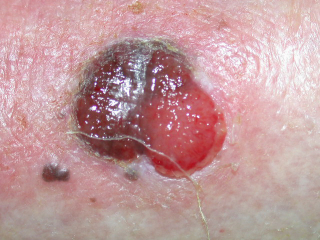Melanoma causes
Editor-In-Chief: C. Michael Gibson, M.S., M.D. [1]
|
Melanoma Microchapters |
|
Diagnosis |
|---|
|
Treatment |
|
Case Studies |
|
Melanoma causes On the Web |
|
American Roentgen Ray Society Images of Melanoma causes |
Overview
Causes

Generally, an individual's risk for developing melanoma depends on two groups of factors: intrinsic and environmental.[1] "Intrinsic" factors are generally an individual's family history and inherited genotype, while the most relevant environmental factor is sun exposure.
Epidemiologic studies suggest that exposure to ultraviolet radiation (UVA[2] and UVB) is one of the major contributors to the development of melanoma. UV radiation causes damage to the DNA of cells, typically thymine dimerization, which when unrepaired can create mutations in the cell's genes. When the cell divides, these mutations are propagated to new generations of cells. If the mutations occur in oncogenes or tumor suppressor genes, the rate of mitosis in the mutation-bearing cells can become uncontrolled, leading to the formation of a tumor. Occasional extreme sun exposure (resulting in "sunburn") is causally related to melanoma.[3] Those with more chronic long term exposure (outdoor workers) may develop protective mechanisms. Melanoma is most common on the back in men and on legs in women (areas of intermittent sun exposure) and is more common in indoor workers than outdoor workers (in a British study[4]). Other factors are mutations in or total loss of tumor suppressor genes. Use of sunbeds (with deeply penetrating UVA rays) has been linked to the development of skin cancers, including melanoma.
References
- ↑ Who is Most at Risk for Melanoma?
- ↑ Wang S, Setlow R, Berwick M, Polsky D, Marghoob A, Kopf A, Bart R (2001). "Ultraviolet A and melanoma: a review". J Am Acad Dermatol. 44 (5): 837–46. PMID 11312434.
- ↑ Oliveria S, Saraiya M, Geller A, Heneghan M, Jorgensen C (2006). "Sun exposure and risk of melanoma". Arch Dis Child. 91 (2): 131–8. PMID 16326797.
- ↑ Lee J, Strickland D (1980). "Malignant melanoma: social status and outdoor work". Br J Cancer. 41 (5): 757–63. PMID 7426301.